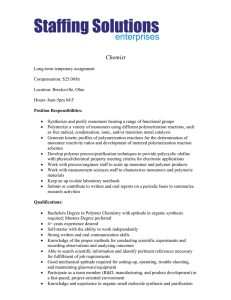Name:___________________________
advertisement
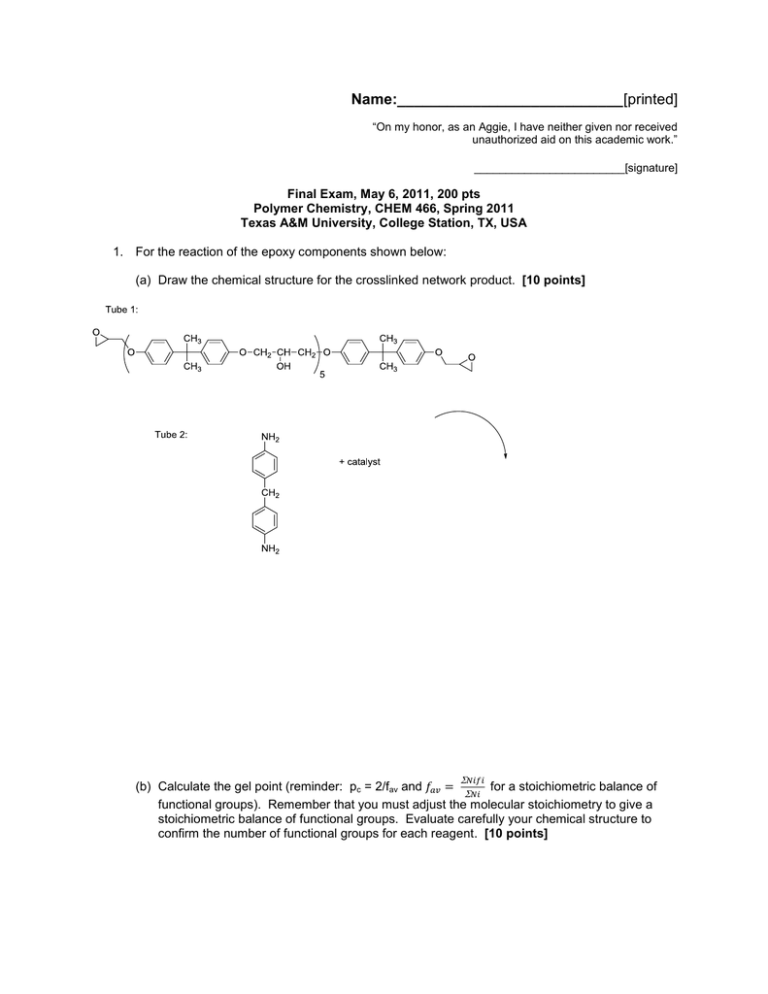
Name:___________________________[printed] “On my honor, as an Aggie, I have neither given nor received unauthorized aid on this academic work.” ________________________[signature] Final Exam, May 6, 2011, 200 pts Polymer Chemistry, CHEM 466, Spring 2011 Texas A&M University, College Station, TX, USA 1. For the reaction of the epoxy components shown below: (a) Draw the chemical structure for the crosslinked network product. [10 points] (b) Calculate the gel point (reminder: pc = 2/fav and for a stoichiometric balance of functional groups). Remember that you must adjust the molecular stoichiometry to give a stoichiometric balance of functional groups. Evaluate carefully your chemical structure to confirm the number of functional groups for each reagent. [10 points] Name:___________________________[printed] 2. (a) Circle the one of the following two polymers that is most likely to be found as a woven fiber in heat-resistant fabric products, e.g. gloves, jackets, pants, with the tradename Nomex, and provide a brief rationale for your selection. [10 points] (b) Provide an example of monomer(s) from which Nomex could be produced. [10 points] 2 Name:___________________________[printed] 3. In 2010, Yokozawa’s laboratory produced interesting diblock copolymers, 1, containing a block segment of polybenzamide structure and a block segment of polystyrene, via a combination of chain-growth condensation polymerization and atom transfer radical polymerization (Huang, C.F.; Yokoyama, A.; Yokozawa, T. J. Polym. Sci., Part A: Polym. Chem. 2010, 48, 2948-2954). Initially, their synthetic approach began from a bifunctional initiator, 2, which contained both a methyl benzoate group to initiate chain-growth condensation polymerization of monomer 3 in the presence of lithium hexamethyldisilazide as a strong base, and an alkyl bromide to initiate atom transfer radical polymerization of styrene. Unfortunately, the chain-growth condensation polymerization failed to provide controlled polymerization conditions to afford 4 (as represented by the X’s through the retrosynthetic arrow and the forward synthetic reaction arrow). Instead, “low monomer conversion (21%) and tailing GPC traces were obtained using initiator 2”. (a) Draw an electron arrow-pushing mechanism for a potential side reaction with 2 that could lead to the observed quenching of the deprotonated, aminyl anion of monomer 3 and give the structures for the resulting side products. [10 points] (b) Draw a second electron arrow-pushing mechanism for another potential side reaction with 2 that could lead to the observed quenching of the deprotonated, aminyl anion of monomer 3 and give the structures for the resulting side products. [10 points] 3 Name:___________________________[printed] (c) The initiator 2 can be prepared by the retrosynthetic step shown below. Given this information, provide an alternate retrosynthetic pathway to produce 4. Be certain to consider possible side reactions, and potential need for protecting groups, as you devise your retrosynthesis. If you choose to use a protecting group, a generic “PG” label and a generic “deprotection” step can be used. [10 points] 4 Name:___________________________[printed] (d) Provide the electron arrow-pushing mechanism for the atom transfer radical polymerization of styrene as a chain extension from 4, serving as a macroinitiator, to afford 1. Label any initiation, propagation and termination steps. [20 points] 5 Name:___________________________[printed] (e) Explain what is being observed in the following overlaid size exclusion chromatography (SEC) traces that were collected as a function of time during the atom transfer radical polymerization of styrene as a chain extension from 4 to give the final block copolymer 1. [10 points] (f) What is the significance of the residual peak at ca. 16.9 mL and how does it relate to your retrosynthetic pathway of part (c)? [5 points] 6 Name:___________________________[printed] 4. Given data from your textbook Table 5.1, indicating that styrene and vinyl chloride exhibit reactivity ratios r1 = 17 and r2 = 0.02 as comonomers M1 and M2, respectively, undergoing radical copolymerization, and Figure 5.1 below: (a) Indicate, with an X drawn at the point on the most relevant plot within Figure 5.1 above, the mole fraction of M1 that would be incorporated into the initial copolymer formed at an initial feedstock of a stoichiometric equivalence of the two monomers. [5 points] (b) Indicate, with an arrow drawn along the most relevant plot within Figure 5.1 above, the direction of change for the mole fraction of M1 that would be incorporated into later copolymers formed as M1 is consumed. [5 points] (c) Predict the overall copolymer composition(s), qualitatively, by drawing the expected polymer structure(s) that would result using a stoichiometric equivalence of the two comonomers and azobisisobutyronitrile (AIBN) as the initiator, with the copolymerization proceeding to ca. complete conversion of the comonomers. Draw out a sufficient number of repeat units to illustrate your answer. [10 points] 7 Name:___________________________[printed] (d) Predict the overall copolymer composition(s), qualitatively, by drawing the expected polymer structure(s) that would result using a stoichiometric equivalence of the two comonomers and the alkoxyamine shown below as the initiator, with the copolymerization proceeding to ca. complete conversion of the comonomers. Draw out a sufficient number of repeat units to illustrate your answer. [10 points] 5. For each of the following polypropylene chain sequences, label each diad as meso, “m”, or racemic, “r”, and identify each type of tacticity. [30 points] 8 Name:___________________________[printed] 6. Propose synthetic routes, giving reaction sequences that include the monomer(s) and any initiator(s) or catalyst(s) that could be used to prepare low density polyethylene (LDPE) and high density polyethylene (HDPE). Draw the polymer backbones of LDPE and HDPE. In this one instance, you are not required to show termination steps or the polymer chain ends. (a) LDPE: [10 points] (b) HDPE: [10 points] (c) Give an experimental technique that could be employed for quantitative characterization of each of the following properties, and indicate the feature(s) that would distinguish the LDPE and HDPE samples (i.e. what differences in the data would be used to determine and differentiate the PE structures?). (i) thermal transition temperatures (i.e. Tg, Tcrys, Tm) [5 points] (ii) degree of branching [5 points] (iii) molecular weight [5 points] 9 Equations, which may be of use: Number-average molecular weight: Weight-average molecular weight: Degree of polymerization: c = extent of conversion of functional groups Polydispersity index: Critical extent of reaction: Average degree of monomer functionality: Textbook: Hiemenz, P. C.; Lodge, T. P. Polymer Chemistry, 2nd Edition; CRC Press, Taylor & Francis Group: Boca Raton, FL, USA, 2007
![Name: [printed]](http://s2.studylib.net/store/data/013223470_1-837fc68222ec80a91ca3a0711550da81-300x300.png)
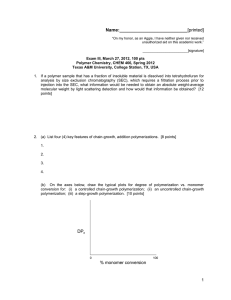
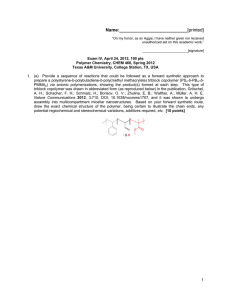
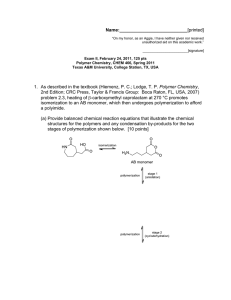
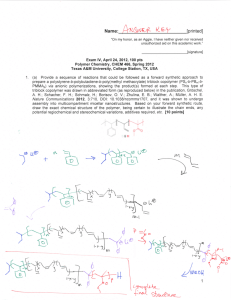
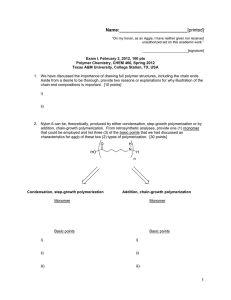
![Name: Jprinted]](http://s2.studylib.net/store/data/013223454_1-05a66cc0fae4685b6e931af12307b6a9-300x300.png)

